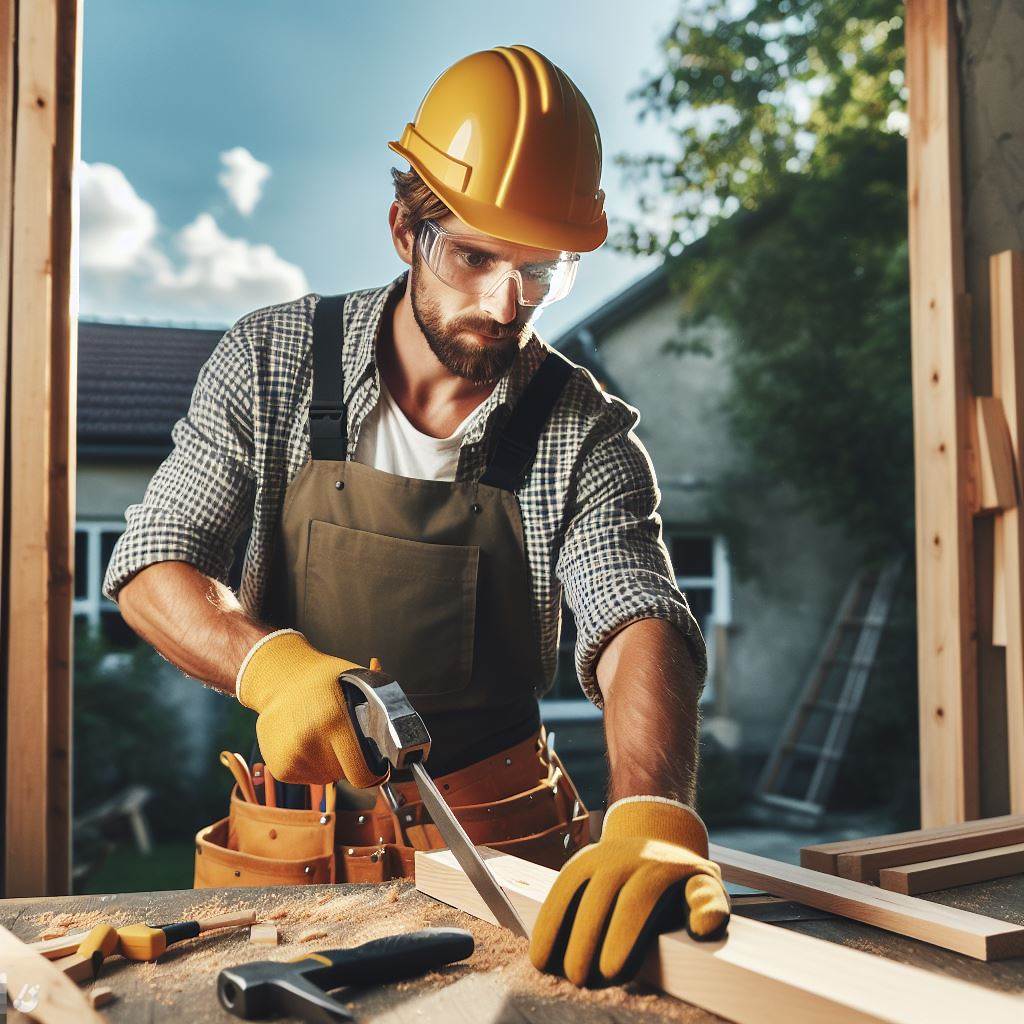Introduction
Carpentry is a skilled trade that involves shaping and constructing wooden structures.
In Canada, the carpentry profession is heavily regulated by building codes.
Understanding these codes is crucial for carpenters to ensure their work meets safety standards and legal requirements.
Carpentry stands as a cornerstone in the construction realm, with its significance deeply entwined with the meticulous adherence to building codes.
In the Canadian context, the synergy between carpentry and stringent building codes forms the bedrock of structural integrity and safety.
This intricate relationship warrants exploration, delving into how carpenters navigate and implement these codes to ensure compliance and elevate the standard of construction across the nation.
In this discourse, we embark on an insightful journey into the symbiosis of carpentry and Canadian building codes, unraveling the complexities that underpin the craftsmanship integral to creating resilient and code-compliant structures.
Without a thorough knowledge of Canadian building codes, carpenters risk costly mistakes and potential hazards on job sites.
Are you curious about how building codes impact the art of carpentry?
Let’s explore the intricacies together.
Overview of Canadian Building Codes
A. What Canadian building codes are
Canadian building codes are a set of regulations and standards that govern the construction industry in Canada.
B. The purpose and significance of building codes in Canada
The purpose of building codes in Canada is to ensure the safety, durability, and accessibility of buildings.
These codes are significant in preventing accidents, promoting energy efficiency, and protecting the environment.
C. The role of regulatory bodies responsible for creating and implementing building codes
The responsibility for creating and implementing building codes in Canada lies with regulatory bodies.
- National Research Council (NRC): The NRC oversees the development of national model codes.
- Canadian Commission on Building and Fire Codes (CCBFC): The CCBFC is responsible for the content of the model codes.
- Provincial and Territorial Authorities Having Jurisdiction (AHJs): AHJs adopt and enforce the model codes.
- Canadian Construction Materials Centre (CCMC): The CCMC evaluates and certifies building products and systems.
The model codes created by the NRC and CCBFC form the basis for provincial and territorial building codes.
These codes are continuously updated to adapt to advancements in technology, changes in building practices, and new safety requirements.
Canadian building codes cover various aspects of construction, including structural design, fire protection, plumbing, electrical systems, and accessibility.
They outline minimum standards, specifications, and guidelines that builders must adhere to when constructing or renovating buildings.
In addition to safety, building codes also address concerns such as energy efficiency, sustainability, and environmental impact.
Compliance with building codes is mandatory for all construction projects in Canada, regardless of size or type.
Contractors, architects, engineers, and other professionals involved in the construction industry must stay up-to-date with the latest codes.
Building inspections are conducted by authorities to ensure that construction projects comply with the applicable codes.
Non-compliance with building codes can result in fines, delays, legal disputes, and even the demolition of unsafe structures.
Building codes in Canada are also influenced by international standards, such as those set by the International Code Council and the International Building Code.
In a Nutshell
Canadian building codes play a crucial role in ensuring the safety, durability, and accessibility of buildings across the country.
Unlock Your Career Potential
Visualize a clear path to success with our tailored Career Consulting service. Personalized insights in just 1-3 days.
Get StartedRegulatory bodies, such as the NRC, CCBFC, and AHJs, are responsible for creating, updating, and enforcing these codes.
Compliance with building codes is essential for construction professionals to prevent accidents, promote energy efficiency, and protect the environment.
Read: Rural vs. Urban Carpentry in Canada
Understanding the Role of a Carpenter in Compliance with Building Codes
A carpenter plays a vital role in the construction industry, contributing to various aspects of a project’s compliance with building codes.
They possess valuable knowledge and skills that ensure the construction meets regulatory standards and ensures the safety of the occupants.
A. The role of a carpenter in the construction industry
When it comes to construction, carpenters are responsible for the installation, repair, and construction of structures made from wood and other materials.
They work closely with other professionals, such as architects and engineers, to bring designs to life.
Carpenters are skilled in performing various tasks, including framing buildings, installing doors and windows, building cabinets and furniture, and creating decorative elements.
They have a wide range of abilities, including cutting, shaping, and joining materials to create sturdy and aesthetically pleasing structures.
B. How carpenters contribute to the compliance of projects with building codes
Building codes are regulations that ensure construction projects are built safely, structurally sound, and up to standard.
Carpenters play a critical role in complying with these codes by following the necessary guidelines and requirements.
In terms of structural integrity, carpenters must adhere to specific building codes related to load-bearing structures, framing, and anchoring.
They ensure that buildings are structurally safe and will withstand common stresses such as wind, earthquakes, and heavy snow loads.
Carpenters also contribute to compliance with building codes regarding fire safety.
They install fire-rated doors, construct fire-resistant walls and partitions, and make sure that fire escapes and exits meet the necessary regulations.
C. The importance of a carpenter’s knowledge of building codes
Having a comprehensive understanding of building codes is crucial for carpenters.
Their knowledge enables them to execute their tasks in a way that complies with regulations, ensuring the safety and functionality of the constructed structures.
By staying updated on building codes, carpenters can make informed decisions during the construction process.
They can select appropriate materials, configure structural elements correctly, and implement the necessary safety measures.
Furthermore, a carpenter’s knowledge of building codes allows them to identify potential issues or violations early on.
This helps to prevent costly mistakes and ensures that corrective actions are taken promptly.
In fact, carpenters play a significant role in compliance with building codes in the construction industry.
Their expertise and skills contribute to the safety and structural integrity of buildings while ensuring they meet regulatory standards.
By staying knowledgeable on building codes, carpenters enhance their ability to execute their tasks effectively, ultimately resulting in successful construction projects.
Read: Technological Advances in Canadian Carpentry
The Impact of Building Codes on Carpentry Practices
A. How building codes influence carpentry practices and techniques
- Building codes play a crucial role in shaping carpentry practices and techniques.
- These codes ensure that carpenters adhere to specific standards for construction projects.
- One of the primary considerations imposed by building codes is safety.
- Carpenters must carefully follow safety precautions outlined in building codes.
- These precautions protect both the workers and future occupants of the buildings.
- Building codes provide guidelines on materials, structural stability, and fire resistance.
- Carpenters must select materials and techniques that meet these code requirements.
- By following these codes, carpenters contribute to the overall safety and reliability of structures.
- Building codes also address environmental concerns and sustainability.
- Carpenters need to consider energy efficiency and waste reduction in their practices.
- They must use sustainable materials and minimize environmental impact during construction.
B. The Safety Considerations and Precautions Required by Building Codes
- Building codes prioritize safety to protect both the construction workers and future occupants.
- Carpenters must ensure that their work complies with safety measures outlined in the codes.
- This includes using appropriate safety equipment when working at heights or with power tools.
- Carpenters must also follow guidelines for installing safety features such as handrails and guardrails.
- Additionally, building codes specify fire-rated materials to enhance fire safety.
- Carpenters need to be familiar with these materials and their correct installation methods.
- They must also ensure proper fire-resistant sealing and protection in structural components.
- To comply with building codes, carpenters must regularly update their safety practices and knowledge.
- Continuous education and training are essential to stay up-to-date with safety standards.
- Strict adherence to safety precautions outlined in building codes is crucial to avoid accidents and injuries.
C. Adjustments and Adaptations Carpenters Need to Make to Meet Building Code Requirements
- Carpenters often need to make adjustments to their traditional practices to meet building code requirements.
- They must stay informed about the latest updates to ensure compliance.
- Some traditional techniques may no longer meet the structural or safety standards set by the codes.
- Carpenters need to modify their approaches and use alternative techniques that meet code requirements.
- Building codes may also dictate specific measurements and dimensions for certain structural elements.
- Carpenters must carefully follow these requirements to guarantee structural integrity.
- Furthermore, building codes may have limitations on the type and size of certain construction materials.
- Carpenters need to select appropriate materials that comply with the code restrictions.
- They may need to consult with engineers or architects to ensure code compliance.
- Regular communication and collaboration with other professionals are essential to meet building code requirements.
In essence, building codes have a significant impact on carpentry practices.
Carpenters must consider safety considerations, follow safety precautions, and make adjustments to their techniques to meet building code requirements.
Strict adherence to building codes ensures the overall safety, reliability, and sustainability of structures.
Continuous education and collaboration with other professionals are crucial for carpenters to stay updated and comply with the evolving building code regulations.
Read: Carpentry Safety Standards in Canadian Work

Specific Building Code Requirements for Carpenters
As carpentry plays a crucial role in the construction industry, it is essential for carpenters to have a solid understanding of specific building code requirements.
These requirements encompass various aspects of construction, including structural integrity, fire safety, and accessibility.
Complying with these code specifications is vital to ensure the safety and functionality of buildings.
A. Examples of Specific Building Code Requirements Relevant to Carpentry
Carpenters need to be familiar with and adhere to specific building code regulations in their construction projects.
Here are some examples:
- Minimum size and spacing of structural framing members to maintain the building’s strength.
- Installation of fire-rated doors in designated fire escape routes to enhance fire safety.
- Proper installation of handrails and guardrails to ensure accessibility and prevent falls.
- Use of appropriate materials, such as treated lumber, for exterior constructions to resist decay.
- Compliance with energy efficiency standards regarding insulation and air sealing measures.
B. The Importance of Complying with Code Specifications Related to Structural Components, Fire Safety, and Accessibility
Adhering to building code specifications related to structural components, fire safety, and accessibility is of utmost importance for carpenters.
Failure to comply can lead to severe consequences:
- Structural Components: Following proper structural requirements ensures the stability and durability of buildings, safeguarding occupants and preventing collapses.
- Fire Safety: Installing fire-rated doors, creating fire-resistant barriers, and employing proper fireproofing measures minimize fire risks and aid in the safe evacuation of occupants.
- Accessibility: Incorporating accessible features like ramps, handrails, and wider doorways allows individuals with disabilities or mobility challenges to navigate buildings with ease, promoting inclusivity.
C. Legal Consequences and Job-Related Issues of Non-Compliance
Non-compliance with building codes can have serious legal and professional implications for carpenters:
- Legal Consequences: If a structure fails to meet building code requirements, it may result in legal penalties, fines, or even litigation if injuries or damages occur due to non-compliance.
- Insurance Coverage: Insurance companies may deny claims related to non-compliant constructions, leaving carpenters and their clients liable for any losses.
- Reputation and Job Opportunities: Carpenters who consistently disregard building codes may face damage to their professional reputation, limiting future job prospects and affecting their earning potential.
- Resale Value: Non-compliant constructions may face difficulties in resale, as buyers look for buildings that meet regulatory standards.
In general, carpenters must fully grasp specific building code requirements.
These codes govern the construction industry and ensure buildings’ safety, functionality, and compliance with various regulations.
Compliance is pivotal for carpenters to avoid legal consequences, maintain their professional reputation, and contribute to creating safe and accessible structures.
Read: Canadian Carpentry: History and Evolution
Staying Informed and Updated on Building Codes in the Carpentry Field
Staying informed and up to date on building codes is crucial for carpenters to ensure they are compliant with current regulations.
A. Reliable sources and resources for carpenters to stay informed about building codes
Here are some recommendations for reliable sources and resources to stay informed:
- Government Websites: National and provincial government websites often provide information on building codes, updates, and amendments.
- Building Code Books: Invest in certified building code books relevant to your region, as they are comprehensive and authoritative sources.
- Industry Associations: Joining carpentry associations can provide access to valuable resources, newsletters, and updates on building code changes.
- Online Forums and Discussion Boards: Participate in professional online communities where members discuss building codes and share knowledge.
- Local Building Departments: Establish a good relationship with local building departments to receive direct updates on any changes in the codes.
- Code Training Courses: Attend specialized training courses that focus on building codes in the carpentry field.
- Newsletters and Publications: Subscribe to newsletters and publications that specifically cover the construction industry and building codes.
B. Methods for continuous professional development and learning in relation to evolving building code requirements
Continuous professional development is vital for carpenters to keep up with evolving building code requirements.
Here are some methods to consider:
- Continuing Education: Enroll in continuing education courses that specifically address building codes and their updates.
- Workplace Training Programs: Seek opportunities for in-house training programs provided by your employer.
- Code Seminars and Webinars: Attend seminars and webinars focused on building codes, organized by industry associations or educational institutions.
- Online Courses: Utilize online platforms that offer courses on building codes, allowing you to learn at your own pace.
- Networking: Connect with other professionals in the carpentry field who are knowledgeable about building codes.
C. The benefits of networking with professionals and attending industry conferences or workshops
Networking with professionals and attending industry conferences or workshops provide numerous benefits:
- Knowledge Exchange: Networking allows you to exchange experiences and discuss building code challenges with peers.
- Mentorship Opportunities: Engaging with seasoned professionals can provide valuable mentorship and guidance.
- Learning from Experts: Industry conferences and workshops often include sessions led by experts who provide insights into building codes.
- Discovering New Products and Techniques: These events allow you to explore new products and techniques that comply with building codes.
- Building Professional Relationships: Networking can lead to professional relationships that can be beneficial for future collaboration or job opportunities.
- Keeping Abreast of Industry Trends: Conferences and workshops provide opportunities to stay updated on the latest trends in building codes.
- Access to Resources: Often, these events offer access to resources such as informative presentations, handouts, and manuals.
By utilizing reliable sources, engaging in continuous professional development, and networking with industry professionals, carpenters can stay informed and updated on building codes, ensuring their work meets the highest standards of safety and compliance.
Conclusion
Understanding and adhering to building codes is of utmost importance for carpenters.
By prioritizing their knowledge of building codes, carpenters can ensure the safety and success of their projects.
Remember, building codes are in place to protect both the carpenter and the building occupants.
It is crucial for carpenters to stay updated with the latest codes and regulations to avoid any legal issues.
Furthermore, being knowledgeable about building codes also increases the carpenter’s credibility and professionalism.
Let’s not forget that following building codes not only guarantees safety but also promotes sustainable and efficient construction practices.
So, carpenters, let’s make it a habit to continually educate ourselves about building codes and apply them diligently in our work.
Together, we can create spaces that are not only visually appealing but also structurally sound and secure.
As a final thought, always remember that in the world of carpentry, building codes are not just guidelines, they are our responsibility.
Stay informed, stay compliant, and keep striving for excellence in our craft.




